Australian
and international
exploratory
performance and
media arts
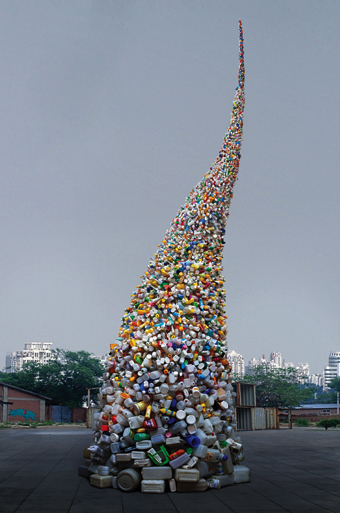
Wang Zhiyuan
b. 1958, Tianjin
Thrown to the Wind, 2010
steel, plastic
photo courtesy of the artist and White Rabbit Gallery
Wang Zhiyuan
b. 1958, Tianjin
Thrown to the Wind, 2010
steel, plastic
IN LEWIS CARROLL’S TALE IT’S THE WHITE RABBIT WHOSE ENIGMATIC CHARM LURES ALICE DOWN THE RABBIT HOLE INTO WONDERLAND. ART COLLECTOR AND PHILANTHROPIST JUDITH NEILSON RIFFS ON THIS SPRITELY CHARACTER’S ASSOCIATION WITH A SENSE OF SERENDIPITY AND SURPRISE IN THE NAMING OF HER WHITE RABBIT GALLERY, A CONVERTED KNITTING FACTORY IN SYDNEY’S CHIPPENDALE DEDICATED TO SHOWCASING A PERSONAL COLLECTION OF POST- 2000 CHINESE ART. STEPPING THROUGH ITS DOORS HAS THE AIR OF ENTERING ANOTHER REALITY, ALTHOUGH GIVEN THE TITLE OF ITS LATEST AND THIRD EXHIBITION, THE BIG BANG, PERHAPS ‘ANOTHER UNIVERSE’ WOULD BE MORE APPROPRIATE.
Here, The Big Bang refers to “the explosion of creativity that has rocked China since its ‘Opening Up’ to the global economy began in 2000.” This hyperbolic premise had me slightly apprehensive I might encounter an exhibition leveraging some of the now commonly hyped assertions characterising discussions of contemporary Chinese art, and in some respects this is what I found. But when the work is this good, concerns over how a show is marketed are best put to one side in favour of focusing on the art itself. Spread across four gallery floors, this eclectic presentation of works from over 35 artists had me enthralled for hours while also considering a broad array of questions around national versus personal identity, alienation in modern life, cultural amnesia and the role of history in present day China and beyond.
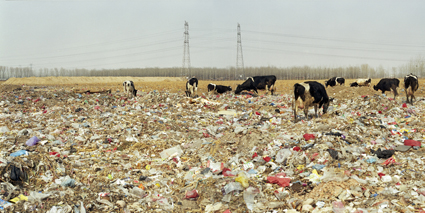
Wang Jiuliang
b.1977, Anqiu City, Shandong
Beijing Besieged by Waste—Guanniufang Village, Xiaotangshan Township, Changping District
40°09’06” N, 116°22’14” E
2009
digital photograph
On the ground floor, two works exploring the flip side of a large population’s increased consumption, its by-product of material waste, stand out for their distinct aesthetic properties. At the rear of the space, Wang Zhiyuan’s spectacular Thrown To The Wind (2010) artfully weaves thousands of discarded plastic bottles around a conical wire frame extending eleven metres to the ceiling, resulting in a whirlwind of waste with a sense of dynamism lent all the greater impact by its overwhelming scale. Nearby, a set of digital prints by Wang Jiuliang, Beijing Besieged By Waste (2009) survey the plethora of garbage dumps that rim the nation’s capital, bringing to mind art writer Carol Diehl’s notion of a “toxic sublime” although the tagging of each photo with GPS co-ordinates emphasises their status as documents. Somewhat at odds with the artist’s environmental campaign is the unwitting beauty in their composition. One image capturing a herd of cows as they scavenge among brightly coloured plastic bags appears almost hyperreal and is eerily tranquil, reminiscent of a traditional pastoral landscape painting albeit with an apocalyptic edge.
Wang Jiuliang’s photojournalism, however, is not characteristic of the majority of The Big Bang artists who prefer to view life through a less literal and more expressionistic lens. Among the most intriguing examples are two mixed media works from multinational Shanghai based art collective, Liu Dao/island6, who work at the interface of art, computers and electronics while seeking to explore “the connections between dreams and waking consciousness.” In Shirt (2009) an LCD screen doubles as a mirror set within a black antique style frame, its surface scratched with finely cross-hatched black lines hinting at an act of vandalism. An infra-red sensor detects the presence of the viewer triggering the projection of an image of a woman onto the mirror/screen where she tries out various poses while dressed in an over-sized men’s business shirt. A witty work, it is also unsettling in its subtle allusion to the voyeuristic impulse that can underscore art viewing and is compelling in its harnessing of technology to delve into the mysterious terrain of desire and the psyche.
The work of Liu Dao/island6 also bears further mention for the way its collective arrangement tests how permeable the boundaries of Chinese art might be. Founded by French artist and curator Thomas Charvériat, now based in Shanghai and drawing artistic collaborators from China, Europe, the US and further afield, this cross-cultural collaboration is certainly a healthy sign of the maturation of the art scene. Yet it also suggests the presentation of contemporary Chinese art may benefit from being geared around more conceptual or thematic lines allowing the work to enter into dialogue with other cultures rather than emphasising its intrinsic “Chinese-ness,” which has become a commodity. This is not to imply The Big Bang is focused on a fixed or historical idea of Chinese art. On the contrary, as its curators point out, much of this work comes from “wired and web-smart products of the one-child policy” who “if their works share a common theme, it is change. And if they have a common perspective, it is ziwo, ‘I myself’.”
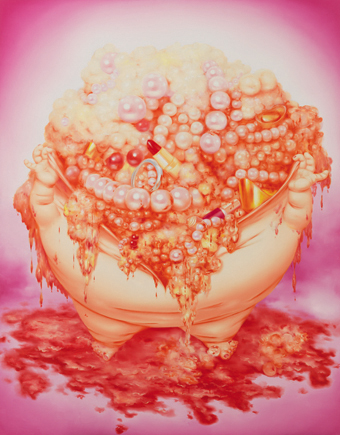
Chen Fei
b.1972, Miaoming, Guangdong
Beyond Satisfaction 2006 No. 2, 2006
oil on canvas
photo courtesy of the artist and White Rabbit Gallery
Chen Fei
b.1972, Miaoming, Guangdong
Beyond Satisfaction 2006 No. 2, 2006
oil on canvas
So then is the individualistic stance of the post-Cultural Revolution generation to be celebrated or deplored? It is a strength of the works on display that a variety of contradictory attitudes emerge. In Chen Fei’s flesh-hued oil painting, Beyond Satisfaction no.2 (2006), the seductive surface belies the grotesque nature of a rotund belly violently split open and spilling forth the shiny goods of feminine desire—pearls, baubles, lipsticks and bands of silver and gold. Clearly here is an artist ill at ease with his society’s relentless desire to consume and accumulate wealth. The attitude of acclaimed photographer and filmmaker Yang Fudong is less easy to pin down. After searching for something sinister in his highly stylised sequence of six black and white film-noir style photographs documenting a well-dressed trio enjoying a night on the town, Ms Huang at M Last Night (2006), it appears the artist is more concerned with challenging viewers to suspend their judgement. As he reflects in his statement “whether you’re filming the life of a rich person or a poor person, there is beauty in both.”
Concluding the exhibition on the gallery’s top floor is a sprawling sculptural installation from Beijing artist Li Hongbo, Paper (2010). Here the artist painstakingly cuts, folds and glues dense layers of brown paper into honeycomb configurations mutating a human figure into a boa constrictor-like form that threatens to engulf the entire space. Dubbed the “slinky man” it is arguably among such supremely confident large-scale sculptural works that The Big Bang really comes into its own. These works might be referred to as “statement pieces” and while some might scoff at the term it is important to remember this is a privately funded collection and as such it reflects an individual’s taste and preferences. Given White Rabbit represents such an extraordinary gesture of philanthropic generosity, this does put up barriers to critique one wouldn’t necessarily encounter in a public museum. Still, where the absence of red tape perhaps weakens the curatorial rigour it also loosens constraints, opening up other opportunities. For viewers, here is a chance to encounter a big, bold and exuberant collection clearly driven by a genuine passion for Chinese art and culture. Certainly the gallery’s label of an “artistic supernova” appears a fitting one.
The Big Bang, White Rabbit Gallery, Sydney, Sept 3 2010–Jan 30 2011; www.whiterabbitcollection.org/
RealTime issue #98 Aug-Sept 2010 pg. web
© Ella Mudie; for permission to reproduce apply to realtime@realtimearts.net
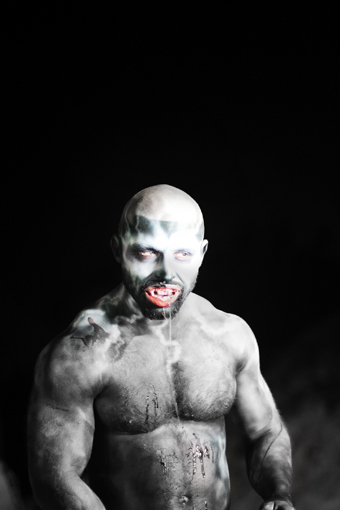
François Sagat, LA Zombie
photo Arno Roca
François Sagat, LA Zombie
AS MARKETING SPIELS GO, MELBOURNE INTERNATIONAL FILM FESTIVAL’S DESCRIPTION OF BRUCE LABRUCE’S LA ZOMBIE CERTAINLY PIQUED INTEREST WITH ITS CLAIM THAT THE FILM FEATURED “PLENTY OF WOUND-SHAGGING AND MORE PENISES THAN YOU CAN SHAKE A STICK AT” (MIFF). EVIDENTLY IT GARNERED ATTENTION FROM THE FILM CLASSIFICATION BOARD, WHICH REQUESTED THAT THE FILM BE SUBMITTED FOR REVIEW AND SUBSEQUENTLY REFUSED TO GRANT CLASSIFICATION EXEMPTION, EFFECTIVELY STYMIEING MIFF’S SCREENING.
Film festivals are normally exempt from the need for certification for the movies they program, as most are unlikely to be released in the domestic market and many will only screen at special events. In recent years it has been rare for a film to be deemed unsuitable even for a festival screening (the last instance was Larry Clark’s Ken Park in 2003, see RT56).
MIFF decided not to contest the decision as the cost of an appeal was prohibitively expensive for the festival (a not-for-profit organisation) and they were advised that any appeal was unlikely to be successful. Further, events happened so close to the festival’s commencement that time factors precluded any appeals process. Technically the film was not banned; rather it was not granted a festival exemption, meaning that it could still be screened if formally classified. Of course the classification process depends on a distributor acquiring the rights, submitting the film for classification and then releasing the film accordingly (with a certificate and perhaps in a cut version)—an expensive, commercial process beyond the financial reach or cultural remit of most film festivals.
The media who readily supported MIFF in 2009, when controversy reigned over the repeated hacking of the festival’s website following its programming of The 10 Conditions of Love, appeared remarkably quiet about the censorship of LA Zombie, dutifully reporting the story and then, apparently letting it die. In the contemporary digital economy it appears to be a given that those interested would probably download the film to watch it. Noticeably, however, the Sex Party’s Fiona Patten drew attention to the censorship of the film as part of a longer ongoing commentary on the issue of censorship in Australia (see press release here).
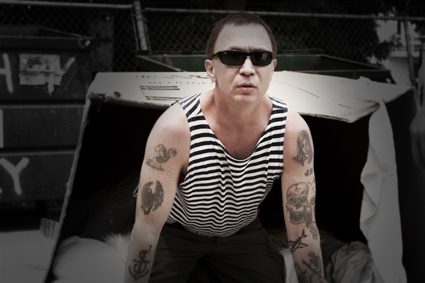
Bruce LaBruce
photo Arno Roca
Bruce LaBruce
FFor those unfamiliar with the director, Bruce LaBruce is an independent filmmaker who emerged from the queer punk scene. His films would no doubt be considered confrontational by those unfamiliar with the radical cinema culture that flourishes beyond the confines of the multiplex screen. His work often depicts sex and has been described as ‘porn,’ although such a description belies its aesthetic velocity and its numerous references to film history and wider radical culture. LA Zombie ups the ante by playing with the horror genre, a form already considered by many as ‘low’ culture. But perhaps the real issue is that the film is ‘gay’. The notion of a same sex zombie ‘porn’ movie is apparently too much for many.
Enter Richard Wolstencroft, the perennial troublemaker of Australian cinema who founded the Melbourne Underground Film Festival when his own work was rejected by MIFF. Since 2000, MUFF has screened cult, genre and underground works, while Wolstencroft himself has frequently railed against the local industry’s more conservative aesthetic and cultural trends. He has authored numerous screeds against what he portrays as the dull and clichéd national cinema in favour of an industry that produces low budget genre movies and radical art house works. Somewhat notorious for his confrontational attitude and his occasionally infuriating pronouncements, Wolstencroft is one of a dedicated handful of curator/commentators anxious to shake up the complacency of many, including their apparent tolerance of censorship. Amongst numerous other ‘infamous’ works, MUFF has programmed Pier Paolo Pasolini’s Salo (1975) and Tony Comstock’s indie lesbian movie Ashley And Kisha: Finding the Right Fit (2007), both of which had been banned.
LaBruce was a festival guest at MUFF in 2004 with his film Raspberry Reich. In the same week that LA Zombie was pulled from MIFF’s program, Wolstencroft announced he would organise a civil disobedience screening in Melbourne with LaBruce’s blessing. While nobody was sure what the police would do, the day before the screening the MUFF director hinted in a Facebook post that he believed the event would go ahead unimpeded, and in the end it did. Ostensibly an addition to this year’s MUFF closing night, the screening took place on Sunday August 29 to a packed house. While MIFF had been unable to fight in this manner, MUFF had publicly declared their decision to stare down the censor.
While rudimentary classification may help uninformed audiences make decisions, censorship is always an ugly beast and should be rigorously fought for reasons of both aesthetic choice and free speech. MUFF rightly challenged the ban. But it did more than this—in beating the ban MUFF has raised some fundamental questions about the way in which films are seen in Australia. Like the low budget genre films that Wolstencroft so often champions, it is the smaller players within Australian film culture that are answering to the challenges of contemporary cinema, the underground and genre festivals, the independent curators and programmers. It is these smaller organisations and individuals that posses the mutability that enables them to respond to events in a manner and at a speed difficult for larger festivals.
Festivals such as MUFF have long fought for freedom of screen culture and should be applauded for their ongoing defiance. More importantly, in screening LA Zombie to an appreciative audience, MUFF has challenged the hegemony of current screen culture. Simply put, if the little guys can fight censorship, then all those who seek an active, lively cinema in Australia should now pick up the challenge and fight to truly free the cinema.
LA Zombie, writer, director Bruce LaBruce, producer Owen Hawk
This article was first published online Sept 20, 2010
RealTime issue #99 Oct-Nov 2010 pg. 26
© Jack Sargeant; for permission to reproduce apply to realtime@realtimearts.net
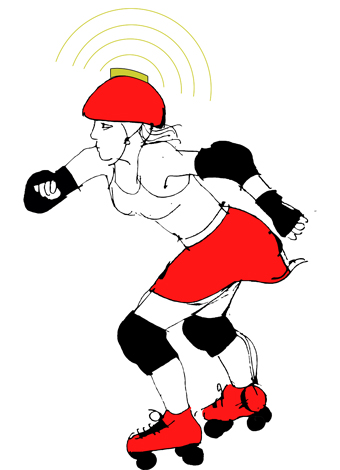
Bloodbath, Bump Projects
image courtesy of the artists
Bloodbath, Bump Projects
blood, sweat and art
In the language of public relations, roller derby is currently having a “moment,” thanks to articles in the Sydney Morning Herald and the Australian as well as Drew Barrymore’s movie Whip It. Bloodbath, however, promises to take roller derby in a slightly different direction.
Conceived by new media artist Linda Dement and billed as a “collaborative distributed artwork,” Bloodbath involves an all girl flat track roller derby game, where sensors are attached to the players. These sensors convey information to a server, which then sends the data on to the five participating artists, who generate their “digital elaborations of the moves and collisions on track” on site and in real time. These elaborations are then projected as the game plays itself out.
Besides Dement, the artists involved include Kate Richards (interviewed in RT80, Sarah Waterson, Francesca da Rimini and Nancy Mauro-Flude, all of whom have track records in new media, data visualisation, mediated performance and work with embodiment or violence. Bloodbath is funded by the inaugural Digital Culture Fund of the Australia Council. Bloodbath, Bump Projects and the Sydney Roller Derby League, Horden Pavilion, October 9, www.bumpp.net
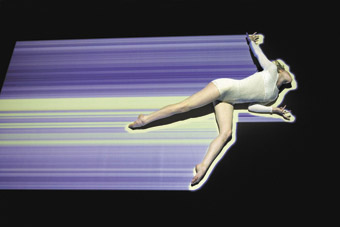
Kristy Ayre, glow, Chunky Move
photo Rom Anthonis
Kristy Ayre, glow, Chunky Move
glow fires again
Chunky Move’s Glow (RT78) has had a long, successful life touring the world, illuminating the possibilities of bringing together dance and interactive media: it now makes a welcome return to Sydney. This deeply engaging, visceral short work was the first of two Chunky Move collaborations with German interactive video artist Frieder Weiss (RT84), the second was the full-length work Mortal Engine.
In Glow the audience peer deep down into the dark at a still form that suddenly convulses into life, scattering about it brimming light, staccato geometries and threatening shadows. What makes Glow, a disturbing evocation of evolution and emergence, doubly exciting is that the light is triggered and controlled by the dancer’s movements making light and movement eerily seamless. Chunky Move, Glow, Seymour Centre, Oct 13-16
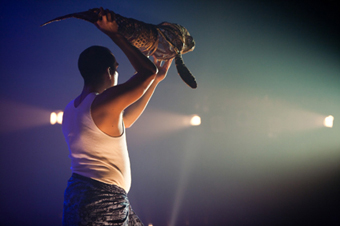
Ilbijerri Theatre Company
photo courtesy of Ilbijerri Theatre Company
Ilbijerri Theatre Company
bold, black, brilliant
That’s the title of the Ilbijerri Theatre Company’s retrospective exhibition, which is currently on display at the Bunjilika Aboriginal Cultural Centre at Melbourne Museum. The exhibition marks the 20th anniversary of Ilbijerri, which was created by Aboriginal and Torres Strait Islander artists in Melbourne in response to seeing non-Indigenous theatre companies telling Indigenous stories.
From the breakthrough production of Stolen, commissioned in 1992, to the upcoming world premiere of Jack Charles v The Crown (a collaboration between the actor and the playwright John Romeril) at the Melbourne International Arts Festival, the company has toured nationally and internationally, finding resonance and critical acclaim with Indigenous and non-Indigenous audiences alike. Along the way we’ve reviewed the company’s Blak Inside season (RT48) and Rainbow’s End (RT66), among others.
The retrospective gives visitors a behind-the-scenes look at life in the theatre company through objects including sets, props and photography from Ilbijerri productions. It’s being displayed alongside From Little Things Big Things Grow, an exhibition about Aboriginal activism in Australia between 1920 and 1970. 20 Years: Bold. Black. Brilliant, curator Ben McKeown, Bunjilaka Aboriginal Cultural Centre, Melbourne Museum, July 9-Oct 31; http://museumvictoria.com.au/melbournemuseum/
made in melbourne
We’ve only just recovered from the Next Wave festival (RT98) but the Melbourne Fringe Festival is fast approaching and the numbers are enough to induce panic: 19 days; 150 venues; and almost 5,000 artists. One of the highlights will be Visible City, which isn’t so much programmed as expected to crop up all over the city at different times and places. It’s described as a “massive cross-artform venture that sees 12 contemporary artists creating new work every day of the festival” (press release).
The artists include some RealTime regulars such as Sarah Rodigari (RT66), Willoh S Weiland (RT88), Lara Thoms (RT76), Jason Maling (RT96) Ingrid Voorendt (RT57), Jennifer Jamieson (RT57) and Michael Yuen (RT66), as well as a few less familiar faces like Rachel Main (Vic), Melody Woodnutt (Qld), Kerry Ann Lee (NZ), Sally Ann McIntyre (NZ) and Joned Suryatmoko (Indonesia).
It’s also worth keeping an eye out for artists who have participated in the Outside Eye development program, run by the Fringe in collaboration with FULL TILT at the Arts Centre and the City of Geelong. This program gives artists 16 hours of one-to-one mentoring with an industry practitioner, the opportunity to attend professional workshops and free space for rehearsal, research and development. This year, the lucky few were Kate Boston Smith, Zoe Robbins, Anne Edmonds, Lisa-Skye Ioannidis, Michael Connell, Linda Beatty, Katrina Rank, Isabel Andrews-Burillo, Sasha Stella, Brodie Maguire, Hoa Pham, Jono Burns, Fregmonto Stokes, Sabrina D’Angelo, Tim Mager, Flynn Hart, Jemma Woolmore, and Justine Makdessi. Melbourne Fringe Festival, Sept 22-Oct 10; www.melbournefringe.com.au/
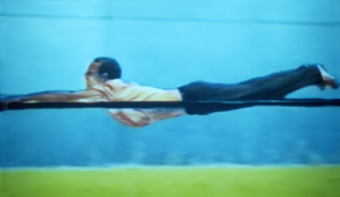
John Meade, Propulsion 2001 (still)
photo courtesy of the artist and Sutton Gallery, Melbourne
John Meade, Propulsion 2001 (still)
objects, diagrams and immersion
Three new exhibitions have just opened at the Perth Institute for Contemporary Arts. First, there is Objects To Live By: The Art of John Meade, featuring works by one of Australia’s leading sculptors (see RT44). Meade’s first major retrospective comprises 17 works ranging in scale from intimate objects on table tops to architecturally scaled wall pieces.
The second exhibition is Love of Diagrams, showing eight contemporary artists investigating “all things diagrammatic.” The artists come from a variety of places—Armando Andrade Tudela (Peru), Bradford Bailey (US/UK), Jose Damasceno (Brazil), Natasha Dusenjko (VIC), Marita Fraser (Australia/Austria), Joyce Hinterding (NSW), Bojan Sarcevic (Bosnia/France) and David Thomson (WA)—and work in a variety of forms including drawing, collage, painting, photography, sculpture, sound art and installation.
Last but not least is Sekilala, the first Australian showing of work by SHIMURABROS, the Japanese brother and sister team Yuka and Kentaro Shimura. Sekilala is a three-screen immersive video installation, shot on super 16mm, filmed in Prague with a storyline inspired by the controversial image of a mouse with a human ear growing on its back. The press release states that “a family drama in which the father is obsessed with bio-furniture erratically unfolds in multiple, fractured stories. Projected onto three screens and randomly configured in 26-shot sequences, the same story is never experienced twice, and the viewer becomes the editor of an infinite and complex film.” SHIMURABROS received the Excellence prize for this work at the 13th Japan Media Arts Festival in 2009. The work has also been shown in Tokyo, Prague and Cannes. Objects To Live By: The Art of John Meade, curator Zara Stanhope; Love of Diagrams, curator Leigh Robb; Sekilala, SHIMURABROS, Perth Institute of Contemporary Art, Sept 11-Oct 24; www.pica.org.au
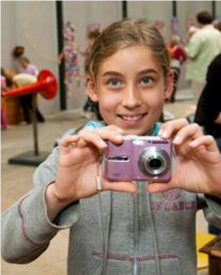
Sydney Children’s Festival, CarriageWorks
photo courtesy of CarriageWorks
Sydney Children’s Festival, CarriageWorks
kids picture the world
The 2010 Sydney Children’s Festival is enticing young photographers and filmmakers to skill up. Benedict Brink’s Digital Photography Workshop focuses on the use of use perspective, colour and natural light to “take a stunning portrait of a friend, capture a landscape masterpiece, or create abstract art out of everyday objects.” In Kyra Bartley’s Make a Film in a Day Workshop participants form a team to “brainstorm and storyboard ideas, cast the actors, hunt for interesting looking locations to film and edit the work to produce the perfect final cut!” In Bartley’s workshop you might end up behind the camera or acting in front of it. In Darryl Cordell’s Picture Us, kids and their families perform to camera to make magical and wacky photographic collages. Sydney Children’s Festival, CarriageWorks, Sept 27-Oct 9, www.sydneychildrensfestival.com
RealTime issue #98 Aug-Sept 2010 pg. web
© RealTime ; for permission to reproduce apply to realtime@realtimearts.net
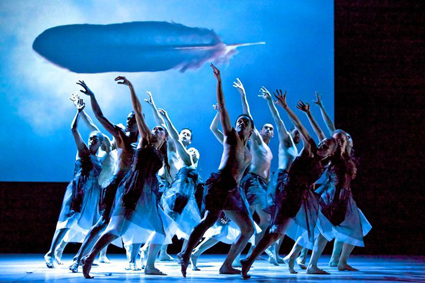
‘Feather’ from Riley
photo Andy Solo
‘Feather’ from Riley
SOFT WHITE CLOUDS DRIFT ACROSS BLUE SKY. OUT OF THE DARK BELOW, ON THEIR BACKS, CRAWLING BUT TORSO AND FACE UP, CREATURES SLIDE INTO DIM LIGHT. THEY WALK, BUT BEND THEIR KNEES TO THE GROUND, ARMS RIGHT-ANGLING OUT. LIKE STRANGE, EMERGENT ANIMALS THEY FORM BENEATH THE IMAGE OF A BOOMERANG AND TWIST, TURN AND ARCH, PERHAPS AT ONE WITH ITS SHAPE AND IMAGINED FLIGHT. THEY STAND, THE BOOMERANG FADES. ANOTHER CREATURE SCUTTLES THROUGH THE DARK AND A LOCUST FORMS BEFORE US, AGAIN ICONICALLY SUSPENDED IN CLEAR SKY.
In Bangarra Dance Theatre’s new season, Of Earth & Sky, the company is introducing a promising new Indigenous choreographer, Daniel Riley McKinley (24 years old, four years with the company) who has chosen as the subject and inspiration for his first major work the cloud series by the late Wiradjuri/Kamilaroi photographer and filmmaker Michael Riley (RT76, p20; RT77, p15). McKinley has selected six of the 10 images—feather, locust, bible, boomerang, broken wing, angel—objects suspended mysteriously in blue skies, and which for him relate most directly to Aboriginal culture. Omitted, for example, is Riley’s jersey cow, an almost comically displaced figure but equally indicative of ruinous environmental and cultural invasion.
Each image is projected onto a large screen behind the dancers and one by one is graphically realized and interpreted. Beneath the locust, dancers’ arms become wings as they cluster in groups and then en masse, to a buzzing electronic score and a riffing, insistent piano. Curiously, the choreography manages to express not only a locust swarm, but also the gestures of those protecting themselves from it in a series of alternations. The plague escalates into highly organized frenzy of sound and movement—straight lines and rapid circles, a fear-inducing army. Just as suddenly it stops. Something else scuttles across the stage.
The Bible, worn leather cover, hovers and a curiously abstract ritual of oppression ensues, hauntingly embodied by Elma Kris and soon multiplied in a row of other women on a diagonal across the stage, gold crosses emblazoned on—or ‘branded on’—their backs. They kneel, hands pushed up behind their backs, as if bound, and their heads drop to the earth. They rise, they stand, walk, go down on their knees as an eerie, distant female choir is heard buried deep in the music. They stand, elbows above their heads, hands behind their heads, palm to palm, like a distorted image of prayer or tortured angel wings, passing before us across the front of the stage and into the dark. The psychological pain induced by an alien religion that converts by bondage is palpable in the sheer otherness of the strange patterns that McKinley makes.
The Bible is replace by a fragmented view of a graveyard sculpture, the Angel. In another powerful episode two men with whitened bodies appear, one borne elegantly on the other’s shoulder, his body in a gentle arc, two bodies as one: is this the Angel? As the carried body extends further out, it’s as if gravity is being defeated. The bodies twist and roles are reversed, carried becomes carrier in the most sinuous of moves, as if on air, in this the most ambiguous of McKinley’s episodes. It’s as if he’s asking, are there angels, divine helpers, and can they be as beautiful and strange as this—and Waangenga Blanco and Leonard Mickelo can answer this for him.
In a mysterious return to the Bible, men in short skirts, the same gold crosses extending the length of their backs, dancing wide-stanced, like Pacific Islanders perhaps, execute obscure tasks, move angularly and fluently dance in a circle of blue light, almost warrior-like in contrast to the equivalent female episode—an image here of some kind of accommodation? McKinley writes in his program note: “The men represent the other side of the religious experience as an exaggerated religious presence.”
The screen turns white. A woman (Jasmin Sheppard) swathed in feathers crawls across the floor to a low cello growl, her body racked, struggling to rise in a painfully exquisite pattern of elaborate moves that seem to engage every part of the body in the effort as Michael Rlley’s Broken Wing image appears on the screen.
Riley’s Feather replaces Broken Wing and the whole ensemble dance: the patterning is formal, the movement light and elegant, no longer saturated with symbolism, animism or literal image-making. As they leave, the dancers gently drop feathers to the floor. McKinley writes that “in Wiradjuri culture, a feather can represent the marking of a journey had…I feel that Riley is my feather, it has connected me to Michael…”
McKinley’s work is sometimes more abstract than the company’s has been, but also at times quite literal, if always about the embodiment of land, animal and spirit and what puts these at risk. There is inventiveness and welcome unpredictability in the choreography, if not always convincingly sustained, and a theatrical assuredness if not always on top of its symbolism. But Riley represents a strong beginning for McKinley’s work with Bangarra and a welcome new vision.
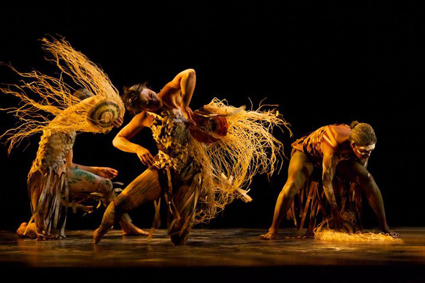
‘Weaving’ from Artefact
photo Andy Solo
‘Weaving’ from Artefact
If McKinley’s Rlley is the sky of the program’s title, Of Sky & Earth, Frances Rings’ Artefact is its earth from the very first image, titled Museum. It’s as if something very alive and alien has sprung from the soil in the form of a large possum cloak that writhes, revealing multiple arms and human legs (Daniel Riley McKinley and Travis de Vries). It’s an astonishing image that gives more than literal life to the idea that this encased museum object once sheltered many people, even across generations; it suggests a spiritual relationship between artefact and wearer and, as Rings writes in her program note, the maker. Artefact is a work of restoration in more than the museum sense of the term.
The next image also astonishes: a pale, out-sized, huge curved bark, such as might be used to carry food, a coolamun, gradually appearing upstage. It will rock, be climbed, turned over, inhabited and appear to float. From it people dance out to forage, the women harvesting with their string bags, the men to grind stones in dances that hover engagingly between representations of making and extended explorations of movement.
In Bodies, the work’s most literal episode, heritage is denigrated by 19th and early 20th century Western attempts to ‘scientifically’ prove that Aboriginal people are an inferior species—the missing link to the Stone Age. If Bodies labours its point with projected images and mechanical movements of measurement to show how Aboriginal people were themselves made museum artefacts, we are soon returned to the magic of objects and their making.
A wary, wide-eyed woman dances sensually in a flowing head-dress and grass skirt and, in Weaving, a huge golden skein of woven pandanus leaves—of women’s making presumably—envelops the men while the women’s dance has been itself a kind of weaving. Then, as often with Bangarra, Artefact concludes communally, if ambiguously. I was left with a rewarding sense of Rings’ restoration of life and spirit to artefacts, their making and makers, realised with Jacob Nash’s design, especially the giant coolamun for its poise and balance, and Gabriela Tylesova’s costumes that so aptly expressed their making.
With its focus on contemporary images and the ancient heritage of artefacts and their embodiment in and through dance, Bangarra’s Of Earth & Sky is an engrossing and thoughtful artistic exploration of a living culture.
Of Earth & Sky is showing at the Arts Centre, Melbourne, September 23 to October 2.
Bangarra Dance Theatre, Of Earth & Sky: Riley, choreographer Daniel Riley McKinley; Artefacts, choreographer Frances Rings; design Jacob Nash, costumes Gabriela Tylesova, composer David Page, lighting Damien Cooper, artistic director Stephen Page; Drama Theatre, Sydney Opera House, July 23-Aug 28
RealTime issue #98 Aug-Sept 2010 pg. web
© Keith Gallasch; for permission to reproduce apply to realtime@realtimearts.net
CD
www.clockedout.org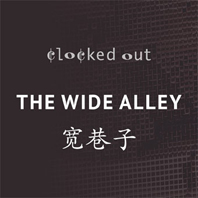
In March 2009 I was entranced by an Utzon Series concert at Sydney Opera House’s The Studio in which Brisbane duo Clocked Out (Erik Griswold and Vanessa Tomlinson) realised a collaboration developed over 10 years with Chinese composer Zou Xiangping and performed with leading Australian and Chinese musicians.
The concert was an entertaining and nuanced exemplar of cross-cultural collaboration. I immediately longed to hear it again, so it was a pleasant surprise to recently receive a fine studio version recorded in Sydney only days after the concert.
The performances lose none of the spontaneity on CD that is requisite for conveying works drawing on and inspired by the traditional street music, opera percussion and folksong of the oldest neighbourhood of Chengdu in China's Sichuan province, melded here with Clocked Out and their ensemble’s Western jazz and avant-garde roots.
As I wrote in my online review of the concert, “Tuning the inner ear,” April-May 2009, “Clocked Out's approach displays a meeting of forms across cultures and musical languages but also allows the musics of Sichuan enough time-space to stand on their own: in the presentation of traditional works, in re-framings of native classics and in wilder experimental fusions where traditional instrumentalists reveal how they can transplant their virtuosity to new terrains.”
My first-hearing responses to the compositions can be read in the concert review. What the CD confirms is just how engaging every composition is and that the performances are uniformly excellent. Soprano Tian Linping not only excels in the soaring vocal style of Chinese opera, but in “Picking Begonias” displays a local style Griswold describes as “a mix of high art with flutter tongue.” As I wrote then, “The effect is of a lilting, gargling trilling complete with astonishing glissandi in a composition replete with passages where flute and erhu (Zhou Yu) intricately entwine.”
Shi Lei’s bamboo flute playing in “Happy Meeting” is magical, the range of notes and effects (astonishingly bird-like in “At Huang Si’s House”) suggest a more sophisticated, much less humble instrument. Zhou Yu’s erhu playing evokes an eloquent, plangent singer in “Two Springs reflect the Moon.” Peter Knight (trumpet), Adrian Sherriff (trombone) and Robert Davidson (bass) provide not only choral propulsion throughout but also moments of reflective lyricism in these democratic compositions.
Griswold’s characterfully spare, incisive piano and Tomlinson’s rich percussion partnering with Zou Xiangping and Zhong Kaizhi collectively provide supple textures and new spaces—the sheer musicality and detail of the percussion is finely captured in the recording of “Sichuan Opera Overture.” As I wrote of the concert version, “Built around gong and cymbals the work engenders rich textures from seemingly limited means, adding timber percussion, then skins, erhu and flute, long bass notes, a call and reply passage and an epic march to the end. The beat is catchy but elusive; as Griswold declares, “the rhythms are unbelievably complex.” Wide Alley was a wonderful concert; now it’s an excellent CD, a tribute to a successful cross cultural collaboration and adventurous composers.
Keith Gallasch
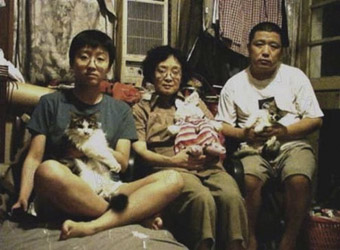
Liu Jiayin, Oxhide 2
[This introduction was written in September 2010. New links will continue to be added to the list below. Eds.]
All nations are more complex than newspaper headlines can ever hope to convey, but few are as bewilderingly diverse, complicated or riven with contradictions as contemporary China. RealTime's coverage of cinematic developments in the People's Republic over the past decade has not only offered a rare glimpse of the evolution of an important popular art form on China's mainland—it has also brought readers' attention to films that offer a Chinese perspective on the history, daily life and social dynamics of this vast and increasingly important country.
China's disparate nature is reflected in its cinema, which encompasses everything from state-sponsored ode-to-the-Party blockbusters—see Mike Walsh's “Mao in the Mall,” RT94—to openly critical DV documentaries. As Walsh wrote in his coverage of the 2010 Hong Film Festival (“Starting Over,” RT97), “Cinema, like most things in China, is expanding rapidly and this expansion is not an easy thing. Film is an arena in which government regulation, market economics and creative expression frequently come into volatile contact.”
RealTime has helped readers explore this complex world by identifying the key filmmakers to watch. Sandy Cameron, for example, wrote a very early appreciation of Liu Jiayin's minimalist portrait of Beijing family life in Oxhide (“A Small Triumph,” RT67), long before the film garnered the recognition that has made it one of the most talked about Chinese features of the decade. More recently, RealTime published the first article in Australia about Zhao Dayong's epic documentary Ghost Town (“Merely Floating in the World,” RT94). Coverage of this important new voice in Chinese cinema continued with Mike Walsh's review of Zhao Dayong's first drama, The High Life, at the 2010 Hong Kong Film Festival.
Zhao Dayong has emerged from the ‘unofficial’ documentary sector that operates outside the tightly regulated production and distribution system overseen by China's Communist Party. The roots of this movement stretch back to the dark days of the immediate post-Tiananmen Massacre years, but it was the arrival of cheap DV technology on the mainland at the turn of this decade that really allowed the unofficial sector to flourish. Since then, filmmakers like Zhao Dayong, Hu Jie, Ou Ning and Zhao Liang have created some of the most incisive, critical and heartrending images to come out of modern China. Their work has been explored in recent articles like “From the Dark Side of Economic Success” (RT97) and “China: Alternative Realities” (RT96).
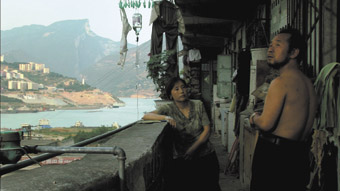
Jia Zhangke, Still Life
If there is one filmmaker, however, whose work best captures the strange, unpredictable conditions under which Chinese people live today, as well as the fraught, ever-shifting relationship between filmmakers and the authorities, it is surely Jia Zhangke. In the past decade Jia has moved from being an unofficial director whose work was banned in China to a recognised artist and recipient of state funding. He has worked across feature-length dramas, short films and documentaries. Through it all he has remained the most consistently creative, discerning and intriguing filmmaker working in China today.
It's a sad indictment of the US and Euro-centric myopia of Australia's mainstream press that this world renowned filmmaker, feted from Beijing to Berlin, Cannes to New York, has barely been acknowledged in Australian broadsheets, despite the appearance of many of his films at festivals around the country. In contrast, RealTime has been able to trace Jia’s development from early notices in coverage of the Hong Kong Film Festival back in 2005 (“A New China Syndrome?,” RT67), to an overview of his career in 2007 (“World Without Bearings,” RT79). More recently, RealTime has published reviews of his latest docu-drama hybrids 24 City (“Where the Truth Lies,” RT94) and I Wish I Knew (forthcoming in RT99).
Unfortunately Jia's absence from mainstream press coverage is symptomatic of a broader, longstanding marginalisation of Asian cinema in Australia. Nearly a decade ago Juanita Kwok wrote in RealTime (“Enter the Dragon,” RT41), “Only three Asian films were released by major motion picture distributors in Australia in 1999, a sad decline from a high of 13 films 10 years earlier.” Although there has been a marked increase in Asian films on Australian screens since that time, there has been scant concurrent rise in mainstream critical interest. As Mike Walsh noted recently (“UnAustralian Cinemas,” RT96), “There is still the assumption that popular sub-titled Asian films… exist within a diasporic ghetto whose walls cannot and probably should not be breached.”
The invisibility of Chinese cinema in Australia’s mainstream press further highlights the importance of RealTime, a publication that doesn’t simply reaffirm what readers think they already know, but rather seeks out the new and unknown. Whether you look at Chinese cinema from an artistic or sociological perspective, the films of recent decades have cast a revealing light on a society convulsed by changes playing out on a scale few of us can really comprehend. Put simply, Chinese films help us understand China. RealTime has helped us understand Chinese films.
Dan Edwards
street level visions: china, the unofficial view
chinese independent docos, melbourne international film festival
RealTime issue #109 June-July 2012 web
monetisation & the new rom-commie
mike walsh: 2012 hong kong international film festival
RealTime issue #109 June-July 2012 p13
riding with dragons
mike walsh: mario andreacchio’s the dragon pearl, ozasia
RealTime issue #106 Dec-Jan 2011 p18
you can’t build on an emptiness
dan edwards: ifchina original studio
RealTime issue #103 June-July 2011 p16
china’s divided screen culture
dan edwards: 2011 hong kong international film festival
RealTime issue #103 June-July 2011 p15
a fistful of renminbi
mike walsh: hong kong international film festival
RealTime issue #103 June-July 2011 p14
shanghai: fractured memories, contested histories
dan edwards: jia zhangke’s i wish i knew
RealTime issue #99 Oct-Nov 2010 p17
from the dark side of economic success
dan edwards: films by zhao liang and guo xiaolu, hong kong film festival
RealTime issue #97 June-July 2010 p16
starting over: new chinese cinema
mike walsh: hong kong film festival
RealTime issue #97 June-July 2010 p15
unaustralian cinema
mike walsh: asian film in australia
RealTime issue #96 April-May 2010 p17
china: alternative realities
dan edwards: the digital documentary filmmaker generation
RealTime issue #96 April-May 2010 p15
merely floating in the world
dan edwards: zhao dayong’s ghost town
RealTime issue #94 Dec-Jan 2009 p22
where the truth lies
dan edwards: jia zhangke’s 24 city and cry me a river
RealTime issue #94 Dec-Jan 2009 p23
mao in the mall
mike walsh: the founding of a republic
art, commerce, action!
dan edwards on the ambitious yunnan new film project
RealTime issue #84 April-May 2008 p17
from chinatown to china
dan edwards on an australia-china animation co-production
RealTime issue #82 Dec-Jan 2007 p20
world without bearings
dan edwards on the vision of chinese filmmaker jia zhang-ke
RealTime issue #79 June-July 2007 p17
cinemas of possibility
dan edwards on new asian films in the adelaide film festival
RealTime issue #78 April-May 2007 p17
emerging chinese cinema
mike walsh at the 2006 hong kong film festival
RealTime issue #73 June-July 2006 p26
high roads to china
mike walsh on chinese cinema
RealTime issue #69 Oct-Nov 2005 p17
a new china syndrome?
mike walsh
RealTime issue #67 June-July 2005 p20
a small triumph
sandy cameron
RealTime issue #67 June-July 2005 p22
an asian-centred australian cinema
mike walsh
RealTime issue #61 June-July 2004 p16
soon: film: the asian-australian connection
RealTime
RealTime issue #50 Aug-Sept 2002 p24
enter the dragon
juanita kwok: asian film in australian cinemas
RealTime issue #41 Feb-March 2001 p13
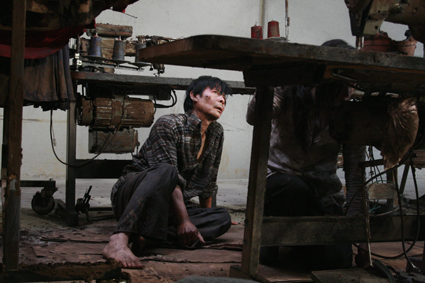
Hieu Phan, Mother Fish
photo courtesy of Titan View
Hieu Phan, Mother Fish
KHOA DO’S NEW FEATURE FILM MOTHER FISH BEGINS WITH A BLACK SCREEN, THE SOUND OF RUNNING WATER AND THE OFFICIOUS TONES OF KEVIN RUDD. THE THEN PRIME MINISTER IS ANSWERING MALCOLM FARR, POLITICAL REPORTER FOR THE DAILY TELEGRAPH AND OCCASIONAL COMMENTATOR ON THE ABC TV’S INSIDERS, WHO IS ASKING ABOUT THE “12 BOATS AND 700 PEOPLE” THAT HAVE RECENTLY ARRIVED AT CHRISTMAS ISLAND AND THE POSSIBILITY OF REINTRODUCING MAINLAND DETENTION CENTRES.
The reply is vintage Rudd (“there’s a purpose-built facility there for that purpose”) but it fades into the background as sound of water grows louder and the camera focuses on a pair of hands washing and chopping vegetables. We hear a voiceover in Vietnamese, spoken in the second-person: “What are you cooking today? You only ever eat greens…You always put too much sugar…I’ll wait for you in the car. Don’t forget to turn the TV off.” The volume on Rudd’s voice increases again and we hear him saying “boats [have] been coming to this country, Malcolm, as you know, since the 1970s.”
From here, we follow the woman (Hien Nguyen) as she drives to work—a small factory with several sewing machines and multiple racks of identical clothing (trendy red checked shirts and long purple skirts). The female voice accompanies her throughout the day and when everyone finally departs in the evening, the woman stays to retrieve a toy monkey that she, or rather the voice, has taken a liking to. The monkey clearly triggers something in her as the present falls away, the past intrudes, and the voice pleads with her to stop.
In an instant the factory transforms into a small boat, with a sewing machine standing in for a motor, a bobbin for a pull cord, and a skirt for a sail of sorts. This rather Brechtian approach, reminiscent of Lars von Trier’s Dogville, is not without its risks but for the most part it works. In this way, Mother Fish effects an unusual reversal: having previously made a rather filmic piece of theatre (RT86), director Khoa Do has now produced a rather theatrical film.
In the absence of actual ocean, the film evokes its presence through camera movement (constantly pitching up and down, as if on a heaving sea) and sound effects (water slopping against the side of the boat, the low drone of the motor). Similarly, the set transforms over the course of the film from a steel-toned workshop—all grey, gold and silver with the occasional shot of red thanks to the bobbins of thread—into a rusted, blasted and scorched shell of itself, barely recognisable under a layer of brown mud.
On board the “mother fish” are the two sisters Kim (Kathy Nguyen) and Hanh (Sheena Pham), their uncle (Hieu Phan) and a young man Chau (Vico Thai). Sailing out of the harbour, the sisters argue about what they have been allowed to bring and what their mother might have packed for them. However the argument comes to an abrupt end when they hear the sound of a patrol boat and shots bring fired. Once out onto the ocean, the journey alternates between boredom and terror. During the dull patches they remember the past (dad’s exploits, mum’s food) and rehearse the future (“you’ll never have to cook again because everything comes in a can: chicken in a can; cow in a can; fish in a can”). However these moments are few and far between as the mother fish and her crew endure horror upon horror: first the boat is attacked by pirates, who rape one sister while another watches; then they are forced to forfeit a precious necklace to bribe an official to tow them into a refugee camp where they are then pushed back out to sea; later Chau jumps ship never to be seen again while Hanh teeters on the brink of death.
These scenes have the potential to be voyeuristic on the one hand or sentimental on the other, but remarkably they are neither. Instead, this film sails straight and true thanks to the immense restraint of both its actors and director. For their part, the actors play the scenes with absolute control: emotion is evoked through little more than a turn of the head, a glimmer of a tear, or a gentle look of affection. What little dialogue there is, is spoken with sensitivity and nuance and Thai’s reading of the line “I’m sorry, I’m sorry” hints at his character’s pain and regret as well as compassion. This emotional and verbal reticence is complemented by Do’s visual restraint. For example, when filming the rape scene, gauze drops down over the lens as if to screen it out. Similarly, when characters are at their most vulnerable and distressed often all we see is a cheekbone, a veil of hair or a hunched shoulder.
In the final scenes, we see the younger Kim washing onto the shore and touching the feet of her older self. Once again the camera hovers over the older Kim’s shoulder as we follow her home. She attempts to cook a meal but unnable to eat she instead goes for what we think is a walk in the park. However, when the camera finally tilts down it becomes apparent that she has walked into a pond and is plunging into the water. Several silent seconds later (the soundtrack is effectively minimalist), her younger sister and her younger self burst from the water, gasping and reaching for one another. In one of the final images of the film, a small hand reaches for a larger, older one and we hear (once again in Vietnamese), “Sister, is that you?”, to which Hanh replies, “I’m here.”
The film finishes with the astounding statistic that between 1975 and 1996, over 1,500,000 people fled Vietnam. Of those, only 900,000 made land meaning that 600,000 were lost at sea, a catastrophe on a par with 1,700 SIEV Xs. Of the survivors, approximately 137,000 came to Australia. It is now 35 years since this migration started, yet it is only in the past 10 or so years that these stories have started to emerge into the mainstream. Think for instance of exhibitions such as the Casula Powerhouse’s Viet Nam Voices (1997), Viet Nam Voices: Australians and the Viet Nam War (2001-03) and Nam Bang! (2009) (RT90) as well as Nam Le’s book The Boat (2008). Perhaps the first generation was so busy surviving that it is only now, as the second generation makes its mark on the world and starts to have children of their own, that these stories can be told.
Intriguingly, Do is also planning to tell stories with and about other refugee communities. Mother Fish is the first in a planned “refugee trilogy” with the second film, Falling for Sahara, already in post-production and the third in the early stages of development. Mother Fish suggests the trilogy has the potential to become an Australian film classic.
Mother Fish, writer, producer, director Khoa Do, executive producer Matthew Riley, performers Kathy Nguyen, Sheena Pham, Hieu Phan, Vico Thai, Hien Nguyen; Australia, Titan View
RealTime issue #98 Aug-Sept 2010 pg. web
© Caroline Wake; for permission to reproduce apply to realtime@realtimearts.net
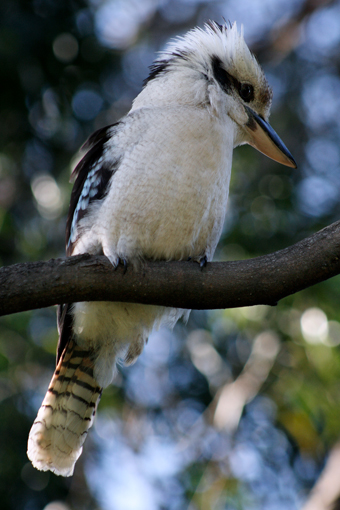
Kookaburra
photo Yorrick (bonehead)
Kookaburra
musical workers
WHEN JAY ‘JP’ PARRINO COVERED MEN AT WORK’S “DOWN UNDER” ON AUSTRALIA’S GOT TALENT IN LATE 2009, ONE COULD WITNESS CULTURE IMPLODING IN MANY WONDERFUL WAYS. EMPLOYING LIVE SAMPLING TECHNIQUES, HE BUILT UP LAYERS OF ACOUSTIC GUITAR TO CREATE A POVERA DIGITALIS TYPICAL OF THE CONTEMPORARY BUSKER. WHILE JP’S DEVICES WERE PERCEIVED AS A NOVELTY BY THE SHOW’S AUDIENCE AND JUDGES, HE EMPLOYED THEM AS MEAGRE USER-FRIENDLY TOOLS, NOT AS FLASHY INSTRUMENTS. HIS MODUS OPERANDI WAS TO LITERALLY BUILD A BACKING FOR HIS VOICE AND ACOUSTIC GUITAR ACCOMPANIMENT.
Performing against and with live looping was instigated by Alvin Lucier in the 60s, developed by Robert Fripp in the 70s, spectacularised by the Young Gods in the 80s, matrixed by Jeff Mills in the 90s and deployed with virtuosity by Battles in the 00s. It’s safe to say that live looping is now a given vernacular in the technological production of music. Occurring within a mainstream context like Talent, JP’s use of the process demonstrates well how musical culture is now shaped. He simultaneously deconstructed ‘the song’ (voiced by Men At Work) and aurally constructed ‘a song’ (voiced by JP). The song this man made through his work clearly connected to both live and televisual audiences by virtue of how deftly he collapsed what was his and what was not. In an era wherein media has moved from saturation to atomisation (from the congealment of large forms to the unleashing of fine particles), performances like JP’s populist yet radicalised rendering of “Down Under” demonstrate how musical texts now implode without losing their identity.
In shows like Talent, the surrendering of the performer to his/her performance marks the event as a social communion for those within earshot. As a desultory figure unconverted to the show’s jingoistic narrative, I try to maintain distance from its Red Rooster-like moniker, its flag-waving set design, its pathetically professional panel, its bug-eyed audience, its predictable swells of applause. Yet I cannot deny the power of song, of singing and of an audience enthralled by a singer’s self-surrendering performance. True to the diacritics of folk culture, JP’s version sets up a dialogue with the original Men At Work version, and the two are empowered by a textual link where the songs speak to each other as much as they speak to me as an auditor of their voices and voicings.
Now, those with refined Rock sensibilities have long made sardonic quips about the numerous competitive TV shows based on Pop musical performance (the global franchises of Idol, Talent etc). But might not the predominance of these spectacles of amateur gumption, innocent drive and hysterical dreaming reveal the role song plays in popular culture? Songs are a particularly dialectal form of expression and intercommunication. The simple musicalisation of argot—of whittling a melody out of a popular epigram—is a form of linguistic sonography born of a living, breathing culture. Words are always at a fork in the linguistic road: they can turn one way to be weighted by their written inscription (the rationalist law of the text) or turn the other way and be airborne by their melodic transformation (the transcendent charm of the song). Say something enough times and it will eventually be sung.
mean larrikins
If there is one demographic watching and listening to Australia’s Got Talent on Channel 7, there must be another one watching Spicks And Specks on ABC. And if the former is defined by the supposedly insidious machinations of the Pop industry’s controlling of audiences incapable of articulating their relation to song other than mere consumption, then the other must be inversely defined. Despite being largely ignorant of the fact that the ABC stole the format for their 2005 show from UK Channel 4’s 1996 show Never Mind the Buzzcocks, the Spicks audience is congratulated on their upwardly mobile shift toward knowing when they are being manipulated and when they are not. The format of the show smacks of puerile academicism—uncomfortably echoing the panels first televised in Channel 7’s It’s Academic in the late 60s. Comedians, of course, are used to distract audiences from such irksome fare, but watching wannabe-cool comedians and grinning presenters fall over each other trying to prove their wit constitutes a far more embarrassing performance than the most inept of Talent’s hopefuls.
There are scant fragments in the televisual stream of Spicks that do not stray from the high-versus-low culture ossification which unwisely emboldens the intelligentsia. The trivia format suits the trivialisation of Pop music in general, while the show’s incorporation of local and select overseas touring musicians fluffs up its notion of ‘real/true/roots/indie/non-mainstream/Rock’ musical culture. It’s a show suited to parents who remember their tertiary education via playlists garnered from JJJ. Like everything on ABC TV, the ideological compaction and congestion of its slanted views, adopted poses and supported truisms make it an insult to bother applying any semiotic reading of its monophonic voice.
But a late 2007 “Children’s Music Edition” episode on the show became unintentionally infamous when one question innocently proposed a melodic connection between the 1934 Girl Guides campfire sing-along “Kookaburra” composed by Marion Sinclair, and fragments of the flute interlude in Men At Work’s international number one song from 1981, “Down Under.’ Less than two years later in mid-2009, the purported owner of the copyright of Kookaburra—Larrikin Music Publishing—claimed copyright infringement of said property and moved to sue the owners of “Down Under”’s copyright—EMI Music Publishing Australia and co-composers Colin Hay and Ronald Strykert.
A lot of press has since danced a predictable waltz around this case: freedom of speech; money-grabbing lawyers; pop music always ripping-off; denial of technical harmonic quotation; ethical averment of fair usage etc. The intersection of the arts and legality exacts such a tiresome charade of grandiose ethics. This case is not about money, music and ethics. It’s about the forced divide between pop culture and folk culture (in shows like Spicks). It’s about how the two are implosions of the other, how they live off the other, and how their mechanisms are now more than ever shared (as in shows like Talent). And it’s about how the intelligentsia slathers ethical-mongering, political-correctness and proscriptive-nationalism on such a public incursion of national identity crisis (as in the Larrikin vs EMI case), rather than provide contextual, critical insight into the deeper issues which shape these cultural ground swells.
thieving magpies
Like the atomisation which now defines ‘war’ as an asynchronous concatenation of disparate events and locations with no holistic sense of convergence or interconnection, ‘cultural wars’ no longer require metaphors based on Great Wars, where notions of frontlines and avant gardes romantically heroicise how individuals contribute to the shaping of culture. This is ultimately a good thing, for culture—from its conservative models of anthropology to its radicalising models of neurology—is best interpreted as noise of the crowd rather than scripture of an author.
“Down Under”’s para-conscious quipping and cribbing of “Kookaburra” can be viewed semiologically (though not ‘legally’) as a therapeutic retort to having suffered the indoctrination of “Kookaburra” in primary schools, where kids were forced to listen to such songs broadcast on ABC radio through PA systems fixed atop the blackboard in a scenario straight out of George Orwell’s paranoid mind. Am I alone in detesting Kookaburra and every single faux-folksy, pseudo-pioneer, colonial-jumbuck, banjo-jangling ditty which the ABC ideologically served up as part ‘children’s music’ and part soft enforcement of a default-leftist, neo-Maoist, pro-Folk, anti-Pop statement of Australiana? Both Kookaburra and the Larrikin copyright claim recall an epoch of reclaiming iconography for a dangerously jingoist, post-convict liberation, with Blinky Bill, the Easter Bilby, Cuddlepie and the Southern Cross rebutting overseas imperialism. (Ironically, it was the populist “Down Under”—through its appropriation by Australia II upon winning the America’s Cup in 1983—and not any folksy tune that sung the praise of Australia internationally.)
When Larrikin sued Men At Work, they impressionistically painted their case like the Eureka Stockade, with true blue Australian Folk music battling the corporate ogre EMI. Larrikin—personified by the APRA-lauded aegis of self-appointed Australian folk historian Warren Fahey—has long wheelbarrowed a divisive and separatist notion of Australian Folk music, often intoned as if a local hero is struggling to gain respect for the unsung songsters of white rural colonial history. Yet if Larrikin adopted a modern, diffusive notion of Folk dissemination, they would realise that their battle was long won once Qantas Airlines forced its boarded patrons to suffer a broadcast playlist of semi-acoustic, pub-rockish, sunburnt country Aussie spirit fodder (remarkably similar to the ‘live’ sounds on Spicks). The risible iconography that attempts to monopolise the Australian voice as one big rural campfire round is as ideologically loaded as chants on Cronulla Beach. When Qantas and their corporate brethren of image marketeers broadly assume the cultural validity of such ‘music of the land,’ it suggests that what Larrikin would claim to be Folk is now the most pervasive form of nationalistic Pop.
The word “kookaburra” comes from the Wiradjuri “guuguuburra.” The voice of the kookaburra underwent indigenous and colonial linguistic translations before the Girl Guides claimed kinship with its song via the colonising practice of western diatonic harmony. While Larrikin attempts to grandstand a mean-spirited sense of folk culture by suing Men At Work as the Girl Guides Association celebrate their centenary, lyrebirds mimic car alarms, bell birds interface with mobile phones, bowerbirds collect plastic bottle tops. And magpies continue their chattering in the magpie culture of music wherein all is borrowed, all is robbed, and all is sung.
RealTime issue #98 Aug-Sept 2010 pg. web
© Philip Brophy; for permission to reproduce apply to realtime@realtimearts.net
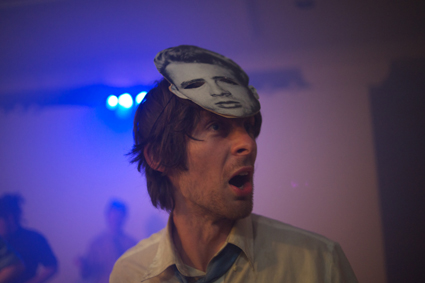
Robbie O’Brien, Room 328
photo Morgan Roberts
Robbie O’Brien, Room 328
MAKE ART. DRINK. VOMIT. THIS WAS THE PUBLICITY BY-LINE FOR THE SHOW WHICH AT FIRST SEEMED UNCOMPROMISING, EVEN UNINVITING. THE QUEENSLAND GOVERNMENT HAS DECREED LOCK-OUTS (OR LOCK-INS, DEPENDING ON WHERE YOU’RE STANDING) FOR CLUBS IN FORTITUDE VALLEY IN AN ATTEMPT TO CURB ALCOHOL-FUELLED STREET VIOLENCE IN THE WEE HOURS. ON A STRICTLY MICROSCOPIC, SOCIOLOGICAL LEVEL, ROOM 328 IMMERSED US IN A TACTILE, DIRECT TAKE FROM A MASCULINE PERSPECTIVE ON CLUBLAND (OR NEVERLAND, AS DIRECTOR DANIEL SANTANGELI EXPRESSES IT, REFERRING TO PETER PAN’S LOST BOYS).
These are Boys with No Sense of Limits, dedicated to the time-honoured prerogative of young males to live fast, die young and leave a good-looking corpse. Some of them, of course, fulfil their wish. The piece represents men’s need to interpose violence in order to protect themselves from closeness and personal connections. On a deeper, more poetic level informing the aesthetic values of the production, the audience was being asked to contemplate the pain of these vulnerable young men as socially constructed, and ultimately to break the rules, men and women alike, of sex and gender. On entering the space each audience member was fitted with a string bracelet similar to those attached to a baby’s wrists to identify them. Each tenuous thread bore a boy’s name. Similarly, later on, we were asked to wear identical, iconic James Dean masks for a re-enactment of the “chickie run” scene from the cult movie, Rebel without a Cause. I danced with a “boy” who proved to be a ‘girl’, a kind redhead who forgave my clumsiness for a while before moving on to dance with a “girl.” (But real men don’t dance, do they?)
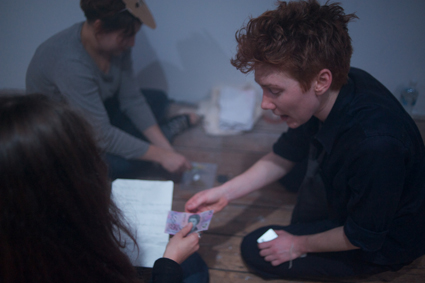
Erica Field, Room 328
photo Morgan Roberts
Erica Field, Room 328
Part dance theatre, part performance art, part installation, the ambient club atmosphere and Willmett’s live sound mix wove together these levels of meaning for the spectator who was free to wander at will. Sometimes the action coalesced round set pieces: the coronation of a king with a cardboard crown; a performer being cling-wrapped to a pillar; the multiple deaths of River Phoenix. Sometimes the audience participated in actions designed to point up our shared humanity
In a poignant ending the mood shifted from all this masculine psychic and physical turbulence to one of pervasive quietude. A sense of peace emanated from the now liquid keyboard tones of Willmett’s soundscape as the performers were winding down. This was a perfect analogue for wandering outside and greeting the dawn with the clear-eyed sense of purgation I’m sure most of us have experienced at one stage of our lives, after an orgy of too many drugs and too much alcohol. It struck the note of absolute, shared verisimilitude I had been searching for throughout the performance. The redhead with whom I’d danced removed the bracelet denoting my spurious masculine identity, freeing me to leave the building reborn, at the same time holding my hand and gaze in an intimate, naked exchange that was delicately touching. But it was still early. I wanted to be contaminated. I wanted a drink.
Room 328 is representative of a new, thoughtful generation of performance makers in Brisbane who are breaking new ground. Three years in the making, this was the first public viewing of a work presented by director Daniel Santangeli and producer Genevieve Trace who have pulled together an impressive line up of their peers including Expressions Dance Company’s choreographer-in-development Liesal Zink, bass guitarist and keyboard player Mike Willmett from local Indie band My Fiction, and local interior designer Elise Terranova. Many of the Room 328 performers trained at SITI Company in New York, founded by Anne Bogart and Tadashi Suzuki. The sheer diversity of talent involved in this ensemble production delivered something pretty amazing.
Room 328, director Daniel Santangeli, designer Elise Terranova, choreographer, Liesal Zink, sound designer Mike Willmett, presenters Allies of Metro & Genevieve Trace; The Galleries, Metro Arts, July 6-10
RealTime issue #98 Aug-Sept 2010 pg. web
© Douglas Leonard; for permission to reproduce apply to realtime@realtimearts.net
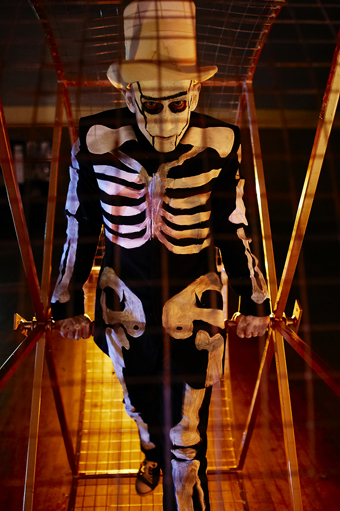
Aerialize, Clammy Glamour From the Curio-Cabinet
photo courtesy of the artist
Aerialize, Clammy Glamour From the Curio-Cabinet
sydney styles a fringe
Unlike Melbourne and Adelaide, Sydney has been without a fringe festival in recent years, putting it on the fringe of the fringe so to speak. However, this is all about to change with Kris Stewart’s inaugural Sydney Fringe Festival. Sensibly, the initial festival is based where its artists are—in the city’s inner west. Stewart states that around 60% of the program is from artists working in and around the Newtown area. Even if you’re living there, you’re unlikely to get to all 200 events so you could focus on theatre or visual arts or the intriguing category marked “other events.” Or you might like to choose a venue such as CarriageWorks, PACT or the Addison Road Gallery and stick with it. You could choose an already widely acclaimed show like Elbow Room’s Tiny Chorus, or a company like Newcastle’s Tantrum Theatre that you’ve seen praised in RealTime, or seek out Aerialize (http://realtimearts.net/article/issue82/8802) who train many young circus and physical theatre performers. Aerialize will be staging Clammy Glamour From the Curio-Cabinet, directed by underground cabaret star Annabel Lines and Legs on the Wall associate Simone O’Brien. The show is billed as “an aerial tale, sparkling ominously in the half-light of a strange and disturbing doll’s house” (press release). Sydney Fringe Festival, September 10-26, http://thesydneyfringe.com.au/; Aerialize, Clammy Glamour From the Curio-Cabinet, CarriageWorks, Sept 15, 16, 17, 23
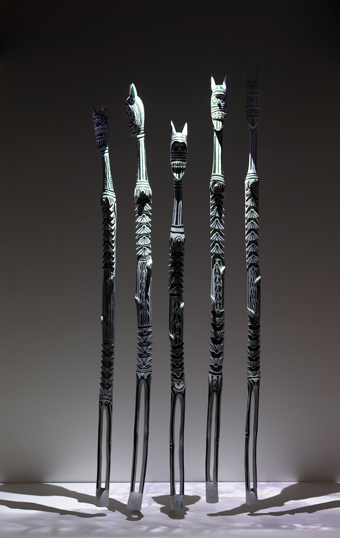
Mokuy, Nawurapu Wunungmurra
photo courtesy of the artist
Mokuy, Nawurapu Wunungmurra
making new media indigenous
The 27th Telstra National Aboriginal and Torres Strait Islander Art Awards (NATSIAA) have been announced. There is some extra excitement this year as NATSIAA has introduced a new prize category in recognition of the growing number of Indigenous artists who are embracing new media as part of their artistic practice. Previously, such works fell into the Wandjuk Marika 3D Memorial Award category (http://www.realtimearts.net/article/issue87/9154). The inaugural Telstra New Media Prize has been awarded to Nawurapu Wunungmurra for his work Mokuy.
Mokuy (spirit) is an elegant sound sculpture with video projection that evokes images and sounds of the coming together of spirits associated with sacred yams, “Morning Star feathers,” scrub fowl and doves at the sacred ground called Balambala: “The Yirritja mokuy come in on the birds djilawurr (scrub fowl) and bugutj-bugutj (banded fruit dove). The Dhuwa mokuy, they come in from rangi side (saltwater).” [http://www.nt.gov.au/nreta/museums/exhibitions/natsiaa/index.html]
The Telstra Award and General Painting Award went to Mr Donegan for his work Papa Tjukurpa, Pukara. Other winners included Glen Namundja for Kunabibbe Ceremony at Manmoyi (Telstra Bark Painting Award), Dennis Nona for Saulal (Telstra Work on Paper Award) and Wukun Wanambi for Bamurrungu (Wandjuk Marika Memorial 3D Award). If you can’t get to the Museum and Art Gallery of the Northern Territory in Darwin to see these and the rest of the 96 pre-selected works go to: www.nt.gov.au/nreta/museums/exhibitions/natsiaa/
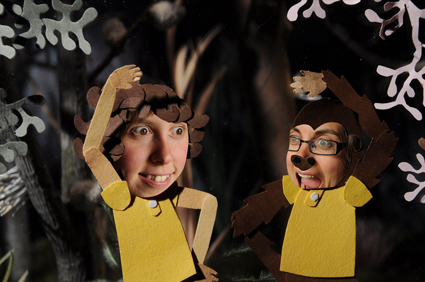
Isobel Knowles and Van Sowerwine
Australia, You Were In My Dream (still) 2010
photo courtesy of the artists
Isobel Knowles and Van Sowerwine
Australia, You Were In My Dream (still) 2010
van sowerine & knowles: winning interactivity
In other media arts news, Victorian artists Isobel Knowles and Van Sowerwine have been announced as the winners of the 2010 Premier of Queensland’s National New Media Art Award, which includes $75,000 prize money. The judges praised their entry You Were In My Dream as “a playful work that offers a rare combination of interactivity, narrative, and nostalgia.” Saige Walton wrote in her review for RealTime of Experiment’s Utopia Now exhibition: “You Were In My Dream is a glorious stop-motion animation that recalls media art history from the vantage point of the present. Functioning as equal parts perspective box, reflective display and interactive installation, the visitor is seated at a booth and provides the stand-in face for a child protagonist (fed live into the animation)” (RT96)
The judges also highly commended Wade Marynowsky’s (NSW) work The Discreet Charm of the Bourgeois Robot 2 2010 as “enchanting, poetic and unnerving” (press release). Other artists short-listed for the 2010 Premier of Queensland’s National New Media Art Award and featured in the exhibition are: Philip Brophy (VIC), Nigel Helyer (NSW), Chris Howlett (QLD), Soda_Jerk (NSW) and Lynette Wallworth (NSW). Their creations are on display at the Gallery of Modern Art in Brisbane. Danni Zuvela will review the works and the judge’s decision in RealTime 99. You can read about the inaugural New Media Art Award in our archive here. Premier of Queensland’s National New Media Art Award 2010, Gallery of Modern Art, Brisbane; http://qag.qld.gov.au/
historical, personal, material, ephemeral
While at GoMA you might also like to see the work of Simryn Gill, whose exhibition Gathering is on display until mid-October. Gill’s work explores the intersection of the historical and the personal, the material and the ephemeral. Bec Dean has previously described her work as “deeply engaging, commanding a gentle seeking of her audience, and a willingness to explore that is no less compelling than the immersive, sensory video installations of Stan Douglas and Bill Viola” (RT42). Gathering consists of a selection works from the past five years, including key photograph series such as May 2006 and Run, the book-based installation Paper boats, as well as Untitled (interiors), a series of bronze sculptures cast from drought cracks in western New South Wales. Simryn Gill: Gathering, Gallery of Modern Art, Brisbane, Aug 28-Oct 17; http://qag.qld.gov.au/
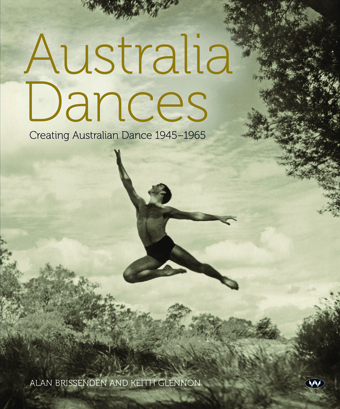
Alan Brissenden and Keith Glennon, Australia Dances: Creating Australian Dance 1945-65
australian dance: the formative years
This handsomely produced book from Adelaide’s Wakefield Press is a groundbreaking account of Australian dance as it took shape, in ballet in particular, between 1945 and 1965. It was a long, hard struggle to build ongoing companies, train Australian dancers and, often most challenging, to create original Australian works. But within a mere 20 years (and with the impetus of the huge popular taste for ballet built by the pre-WWII visits of the likes of de Basil’s Ballet Russes), the Australian Ballet was formed, performing alongside some of its state antecedents.
Written by Alan Brissenden and Keith Glennon, Australia Dances is packed with wonderful black and white photographs, colour plates of set and costume designs (fascinating for their correlation with contemporary art movements) and vivid accounts of a multitude of individual works—replete with eye-witness recollections. Regional companies, dance studios, educational strategies and eisteddfods are given their due, as is Aboriginal dance—the authors highlight the role of the 1961 Darwin Eisteddfod, which included a performance by 15 Aboriginal people, in triggering touring of traditional Indigenous dance by the Australian Elizabethan Trust in the early 1960s. In a country largely bereft of serious, accessible documentation of the performing arts, Australia Dances is exemplary of the kind of books Australian artists and their audiences warrant. Alan Brissenden and Keith Glennon, Australia Dances, Creating Australian Dance 1945-65, RRP $70, www.wakefieldpress.com.au
australian media arts: dream in beijing
Dream Worlds: Australian Moving Image 2010 is a collection of media artworks curated by Melinda Rackham, former director of the Australian Network for Art and Technology and occasional RealTime contributor. It features works by Daniel Crookes, Anita Fontaine, Warwick Thornton, Kate Richards, Jess MacNeil, Troy Innocent, Chunky Move and Peter Miller. Each work is roughly three minutes long with the entire program screening every half hour on large format, open air video display in Sanlitun Villagein Beijing. Dream Worlds: Australian Moving Image 2010, Beijing, Sept 4-Oct 16; www.dreamworlds.com.au
RealTime issue #98 Aug-Sept 2010 pg. web
© RealTime ; for permission to reproduce apply to realtime@realtimearts.net
CD
www.clockedout.org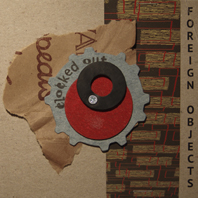
cover and photo Sharka Bosakova
Clocked Out is Vanessa Tomlinson and Erik Griswold, who mesh together beautifully in sound and rhythmic nuance. Tomlinson is a wonderful percussionist, drawing upon an enormous array of things to hit and ways to hit them, and Griswold is a master at preparing the piano and then playing what he has prepared. Foreign Objects is their latest CD. Twelve tracks and 46 minutes. Hand packaged in a cardboard sleeve with a little collage by Sharka Bosakova on the front, each is numbered as something-or-other out of 500.
There are a couple of tracks using the melodica, a theme instrument of Erik Griswold's that sounds like a cross between an asthmatic wheeze and the plastic saxophone that gets broken by the end of Xmas day. I'm not a big fan of the melodica but the tracks grow on me—the chordal pulse of Paniculata bringing back nostalgic childhood memories of warm days, layered curtains, a fly buzzing at the window sill.
But most of the tracks are percussive with melodic fragments. Hold Me Closer sounds like a melancholy twiddle on the piano by the last drunk at an office party, clock loudly ticking in the corner. The jerky a-sync rhythm of Stick This is a vague memory of progressive rock filtered through gamelan repetition, Chinese orchestra and Cageian piano. Toy Feldman brings out squidgy sounds and a music box scratching like a cockroach stuck behind the skirting. Like many of the tracks on the CD there is nostalgia and a certain sadness—an empty room, long held disappointment.
The longest track, at 10 minutes, is Lavendar Mist. It begins with tangled wooden rattling underneath a rapid rhythmic melody that sounds like heavily damped steel drum. Fragments come in and out—hang around for a while, check out the possibilities then go. It reminds me of watching uni-cellular organisms under the microscope as they are buffeted about into Brownian motion.
Throughout the CD, Clocked Out keeps both a sense of regular beat and its fracture, the rhythmic pulse following a wave of acceleration and collapse. There are strange overlays—Griswold might play something dark and rhythmic on piano whilst Tomlinson sounds like she is walking around in a Foley room tapping whatever feels right. This is a real strength of an excellent CD—the coherent layering of consistent and inconsistent attributes into a coherent soundfield that is both abstract and concrete. Walking in the world, leaves crunching underfoot. A stick breaks, loud and cutting through the sound of the music over the ear buds. Things you can guess, things you can't.
Greg Hooper

Refugee Island, Mickie Quick
[This introduction was written in September 2010. New links will continue to be added to the list below. Eds.]
This archive gathers together articles about art that has responded to and represented asylum seekers over the past decade. To a lesser extent it also includes art by refugees themselves. While some art movements are described in terms of war (the avant-garde etc), this one might be better seen as a wave—starting as a minor movement (in 1999), building into something more (from 2000), cresting to reach a critical mass (post-2001), before dropping gently (2005) and receding into the distance (2010), save for an angry swell in the wave of the Liberal party’s “turn back the boats” mantra, with Labor’s “border control” complicity, in the federal election campaign.
Rather satisfyingly, the wave metaphor also redeploys the rhetoric that politicians use when trying to warn us that we are in danger of being “swamped” by a “rising tide”—or better yet a “flood tide,” a “flotilla,” an “armada”—of “illegal immigrants.”
The tactic of redeployment was key to much of the visual art of the period, as evidenced by the culture jamming of Mickie Quick and We Are All Boat People (now boat-people.org). One of boat-people’s members, Deborah Kelly, also co-curated (with Zina Kaye) a more formal exhibition, Borderpanic, which was co-produced by Performance Space and the Museum of Contemporary Art in 2002. In 2003, the computer game Escape from Woomera made headlines when Philip Ruddock and Rod Kemp criticised the Australia Council for funding such a project. Later in 2003, Mireille Astore spent hours on the beach in her installation and performance piece Tampa. Her efforts were then echoed by the SIEV X Memorial, which briefly installed itself at the side of the lake in Canberra in 2005.
Sitting at the intersection of visual art and performance, the durational installations of Mike Parr were also a feature of the period. His painful (re)enactments were unusual in an era dominated by documentary and narrative approaches. The urge to tell one’s story is understandably strong, especially when one has been prevented from doing so by the strict protocols of the refugee determination process or indeed if one has a story about that process itself. Of the many productions that employed this approach, two of the earliest were staged by Urban Theatre Projects: Manufacturing Dissent in 2000 and Asylum in 2001. By 2004, these efforts had started to reach the mainstream, with the Sydney Festival staging Ros Horin’s Through the Wire as a work-in-progress.
Even performances that were not strictly speaking documentary often deployed a documentary aesthetic, such as Bagryana Popov’s Subclass 26A which included snippets of information from application forms and letters. Similarly, Théâtre du Soleil’s Le Dernier Caravanserail—which played at the Melbourne Festival in 2005—also included stories from actual asylum seekers. For their part, Version 1.0 took a slightly different approach, devising a satirical documentary performance CMI (A Certain Maritime Incident) based on the transcripts of the parliamentary inquiry of the same name. Filmmakers also played with the documentary form in films such as Molly and Mobarak (2003), Letters to Ali (2004) and Fahimeh’s Story (2004). Slightly less likely, though no less enjoyable for that, was the comedic fictional film Lucky Miles (2007).
Having just endured another election campaign where ‘floods’ of ‘boat people’ were once again conjured to frighten voters, it is something of a comfort to look back at this archive. This body of work ensures that this period of history will be remembered not only for our punitive policies but also for our artists’ angry and articulate responses to them. Like the policies themselves, these too were performed in our name.
Caroline Wake
visual art
campaign art
caroline wake: art & activism on tv and online
siev x memorial: a pictorial report of the memorial held in Canberra
realtime
tampa microcosm
mireille juchau: mireille astore’s tampa, sculpture by the sea 2003
the meme game: escape from woomera
melanie swalwell
borderpanic remedies
grisha dolgopolov
the artist and the refugee: tooling up for action
bec dean
performance
the refugee’s only currency
caroline wake: powerhouse youth theatre’s mother fish
a shared madness
tony reck at la mama for kit lazaroo’s asylum
chance, dance, animals & the unconscious
philippa rothfield: théâtre du soleil’s le dernier caravanserail
the medium is the audience
john bailey: théâtre du soleil’s le dernier caravanserail
refugees: between reality and performance
kirsten krauth: ros horin’s through the wire
a life between yes and no
mary ann hunter: towfiq al-qady’s nothing but nothing
selves imprisoned and released
philippa rothfield: bagryana popov’s subclass26a
one house, many homes
tony reck: department of human services, mpact, north yarra community health, outside in
version 1.0 shares the shame
bryoni trezise: cmi (a certain maritime incident)
history’s great escape
dan edwards: mike parr and adam geczy’s the mass psychology of fascism, zip-a-dee-doo-dah, zip-a-dee-ay
children overboard: outrage and performance
keith gallasch: version 1.0’s cmi (a certain maritime incident)
the darkness that yields light
keith gallasch: ros horin’s through the wire
cutting through the fog
keith gallasch talks to ben ellis and louise fox about these people
mike parr: internet performance
adam geczy: malevich
bodies at work
keith gallasch: platform 27’s the waiting room
identifying with the refugee
kerrie schaefer: nazar jabour’s no answer yet
sydney & wollongong: atoms and fuel
keith gallasch: claudia chidiac and urban theatre projects’ asylum
degrees of pathos: sydney performance
keith gallasch: urban theatre projects’ manufacturing dissent
film
lo-budget good health
sandy cameron: michael james rowland’s lucky miles
entering the familial web
dan edwards: faramarz k-rahbe’s fahimeh’s story
no time to wait
anna delany talks to clara law
a question of form
jake wilson: clara law’s letters to ali
the documentary: art and survival
tom zubrycki: molly and mobarak
australian filmmakers offer asylum
mike walsh: tales from a suitcase, escape to freedom, anthem




























